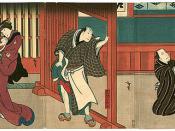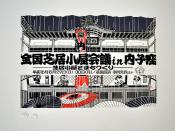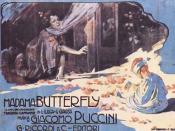Lisa Silberhorn
10/27/02
Classical Asian Theatre
Dr. Debra Martin
Kabuki vs. Puccini
'One fine day' in 1854 an ominous black ship sailed into Nagasaki harbor, prying open the wall that stood between the East and the West. On another 'fine day' in 1904 European audiences saw the premiere of what was to become one of the most beloved operas ever known, using a combination of music from both east and west. Puccini's Madama Butterfly has captivated opera lovers through its exotic sounding music. Said music, is actually a western interpretation of the music found within the treasured Japanese art of Kabuki. This is not so far fetched as one might think. Both cultures have a love of melodramatic musical dramas. Kabuki and Opera are each cultures form of drama, music, and dance combined. When looking at them 'under the microscope' they are not so different from each other. Perhaps the most difficult reconciliation between the two is their music, as both Western and Eastern Music can sound totally different from each other, yet when listening to the music of Madama Butterfly one can find a common ground between the two cultures.
Before discussing the opera itself, one must first 'orient' themselves with the music of Kabuki. The orchestra that performs alongside Kabuki is called the Nagauta. It is said that, "The growth of nagauta is intimately connected with the evolution of the kabuki theatre in Tokyo." (Malm 205) The first recorded performance of Kabuki occurred in 15 96 when Okuni, a priestess performed a lively version of a Buddhist festival dance, accompanied by the drums and flute used in Noh theatre, as well as a small gong which she, herself, played. As Kabuki's popularity grew it became a form of entertainment and advertising used by brothels and geisha houses.
Most Geishas and prostitutes were already proficient in the samisen genre of kouta or "short songs." These were lyrical yet sometimes erotic poems accompanied by the samisen, a double stringed instrument played similarly to a banjo. Most likely, the samisen was first used in a kabuki performance sometime before 1629, when women were banned from the stage, in order to incorporate kouta within a performance. As dances within kabuki were being extended, these "short songs" became insufficient. Thus, longer pieces were written and by 1740, the samisen had become one of the principle instruments of the nagauta. In addition to kouta, the nagauta began to incorporate several other genres of samisen music including joruri, which is where the role of sung narration or commentating began within kabuki. Thus, "the nagauta emerged from combining the lyricism of shorter songs with the sustaining power of longer, narrative music." (Willoughby, 165)
Today the Nagauta consists of the samisen, the Noh flute, the bamboo flute (taken from folk traditions,) and various drums and other percussive instruments borrowed predominantly from Noh or religious rituals. During a performance the Nagauta can be classified into two main groups: the onstage orchestra or debayashi, or the offstage orchestra, also called the geza. The debayashi consists of a row of singers and a row of samisen at the back of the stage. (Eight of each) and the drums and flutes, sometimes referred to as the hayashi are seated in front of them. In Contrast, the geza is in a room in the corner, off of stage- right. This room is sectioned off by a bamboo curtain, hiding the geza from the audiences view, yet allowing the geza to watch the action on stage for cues. Most of the time the geza consists of several samisens and singers of the debayashi, in addition to a myriad of percussive instruments ranging from the temple drums to castanets and xylophones. Each of these instruments is used to produce a desired ambience, or aural setting.
The instrumentation of music for the Nagauta has no dogmatic rules per-say, though generally the singer and samisen perform the principle melodies. The bamboo flute will play bits and pieces of these melodies to support them. The Noh flute, however, is used to play melodies and rhythms that are melodically, tonally and rhythmically different, alongside the samisen and singer who are still singing the principle melody. Other times the Noh flute is used to set the mood of a particular scene, and therefore can be incorporated into part of the geza. If, for example, the play was adapted from a Noh drama, then the flute would be part of the geza, playing original patterns of Noh music as an analogy to that play's heritage. In this case, the Noh flute is often played with the taiko drum and the tsuzumi drums supporting the rhythm. In other cases the tsuzumi and the Noh flute play together while the tsuzumis accompany the samisen in a style called chirikaro. Most likely the samisen and tsuzumi are in rhythmic conjugation while the taiko and Noh flute are playing something rhythmically tonally and melodically different. This is sometimes called the 'sliding door effect' because each instrument may have its own internal rhythmic structure, but do no need to begin and end together. Like a sliding door the musicians seem to come and go as they please rather than exit and enter as with a 'swinging door' that most western musicians follow.
When Commodore Perry pried open the doors of Japan, he began what was known as the Meiji Period, which lasted until 1912. The Meiji Period was a time when the western world delighted in the traditional arts of Japan, beginning a movement of "Japonisme." All of a sudden, anything that had Japanese influence was fashionable. "Once the movement had started, the swarm of amateurs followed," (Eric Chesnau in 1878. qtd. In van Rij) Likewise, the Japanese adopted several hallmarks of western society, particularly within the realm of music. Since then Japan has supported two different musical cultures: the traditional music of the past, with its pentatonic melodies, and gentle nuances, as well as the polyphonic structure of the west, with its opposing counterpoints and chordal progressions.
As most people are familiar with western music, the central theory can be quickly described as follows. Music consists of three major elements, being melody, harmony and rhythm. The melody is the center within the music, that rhythm enhances either by supporting or providing contrast against it. The function of harmony is to 'color' the melody and force movement upon it by either providing tension, or giving release to the movement within a piece. This is accomplished through the use of chords that are related to the melody and its tonal context, also known as the key. The melody itself can contain tension and release but it is the harmony and rhythm that either accentuate or detract from the potential tension and release that is present.
This concept of tension and release within music is prevalent within music written for both western operatic orchestras and that written for a kabuki nagauta. In the case of the Nagauta, although there is no polyphony, that is, harmonic chords, as there would be within western music, (with the exception of coincidental harmonic intervals between differing melodies of the samisen and noh flute.) the unit of the noh flute and the taiko, as described earlier, serve the same function as harmonic chords might do in the west. Furthermore, the tonal independence of the instruments of the nagauta was a regular occurrence long before the first inkling of bi-tonal music in the Western world, which, by the way was during the heyday of Japonisme, and during the same time that Puccini wrote Madame Butterfly.
As far as Puccini's instrumentation goes, he merely is inspired by what is popular at the time. He has no actual Japanese instruments such as the samisen or taiko within the score. This is partially understandable though, because said instruments would be hard to come by in Italy, and furthermore, nobody in that region would understand how to play them, as well as accounting for the fact that there is a completely different notation system for these instruments. However, Puccini does try to create some form of aural ambience by using western instruments that can mimic those of the nagauta. "Instead he combines the normal instruments of the orchestra to produce an exotic color, but one the blends satisfactorily with the rest of the scoring." (Ashbrook 119) One example of this is at Butterfly's entrance. The only instruments playing at this time are the harp, the piccolo, the flute, and the bells, "all in unison, so that they sound like a little Japanese orchestra." (Ashbrook 119) These could be imitative of the samisen the Noh flute, the bamboo flute and the bells of the geza respectively. This occurs again when butterfly shows Pinkerton the possessions that she has brought with her to the marriage; the instrumentation is the same as before.
When Puccini is not imitating Japanese instruments, he still tries to maintain the intimate 'chamber music' feel of several passages. This is accomplished by placing emphasis on simplicity and clarity of the melodic line, as is done in most nagauta music. One beautiful example is the humming chorus. In this scene, Pinkerton's ship has been sighted in the harbor, and Butterfly, confident that he will return to her as he promised three years ago, anxiously watches and waits at the window for him to return. In the orchestra there is a single melody that is sung by the treble chorus, and doubled by muted strings. The woodwinds very softly play an ostinato that merely outlines the potential chords implied by the melody, rather than polyphonically accompanying the melody as a full chord, the way that most western music is written. The piece is still played by a full orchestra, but there are no more than two tunes that are heard by the listener: The fully developed melody, or the ostinato, which, when played together create the same effect as the melodic line carried by the samisen, and the unit of the noh flute and taiko playing another tune, making occasional harmony by playing two note intervals.
Another common trait Madama Butterfly and the music of the nagauta is the use of musical themes. Whether in an eastern or western setting, themes add to the intellectual entertainment of the listener, because one must be familiar with the music already. In modern context, one might be watching Bugs bunny outwit Elmer Fudd by dressing up as a female, and proceed to flirt with him, meanwhile the viewer hears the orchestra play the love theme from Tchaikavsky's Romeo and Juliet in the background. If one did not already know that said theme indicated love or passion, it has no effect on the scene whatsoever. If one is familiar with the theme and its purpose, then one may understand why Elmer is acting so shy, or turning red.
In the case of the Nagauta, thematic music is abundant. "Nagauta.... makes extensive use of a series of stereotype melodic patterns." (Malm, 210) Whether they're called 'melodic patterns' or themes, they can still be used the same way as in much of western music. Most often, standard melodies depict certain moods or emotions. The nagauta could play one tune that implies death and tragedy, or they could play another tune that implies happiness and rejoicing. "Some have said...nagauta composition is not composition but merely arrangement." (Malm 210) This is because the themes themselves have strict meanings that are typically not meant to be broken or experimented with. However, such a statement is overly condescending, merely because of the differing opinions of East and West as to what is artistic. Whereas the West values originality, and improvisation, the East has limited their artistic material so that admiration can be derived from the skill with which the musician operates within a carefully prescribed range.
Another way that theme is incorporated in the Nagauta is by implying a specific setting. As mentioned before, one of the geza's responsibilities is to provide background noise for where a scene takes place thereby aurally creating the setting. This can be effectively accomplished using themes from music with which the audience is already familiar. For a bit of background, Tsukada Island is a major island at the mouth of Tokyo's Sumida River. On the island were numerous brothels and geisha houses. Customers would take chartered boats out to the island. Meanwhile boats full of samisen playing geishas, running alongside them, serenaded the passengers. One of the well-known songs that the geishas would play is called "Tsukada." To revert back to the subject of thematic music produced by the geza, if one were watching a Kabuki performance and overhears the tune "Tsukada," one can assume several things: the setting is most definitely along the Tsukada river, and the scene could be a geisha house our brothel. Comparing it to current western society, one could assume the same idea if one heard "Lady Marmalade," and, thanks to Hollywood, immediately think of the Moulin Rouge in Paris.
Anyone who has studied Puccini will find that he is one of the most thematic composers ever, using melodic themes to represent characters, setting, emotion, and ideas. Madama Butterfly imitates the style of Kabuki in this respect, because Puccini typically uses themes for the setting more often than not. This is partially due to the setting of the opera, and the time in which it was written. As mentioned before, Japan, having spent so long in isolation was a new curiosity to the western world. Consequently, Puccini strove to provide authenticity to his listeners. " With characteristic thoroughness Puccini went to a great deal of trouble to assimilate the musical background of Japan, a study in which we was greatly helped by the wife of the Japanese Ambassador to Rome." (Hughes, 114) Puccini's themes can be subdivided into three categories: those which are authentic, and based off of traditional folk songs, or those that may not be authentic, but incorporate most characteristics of the melodies of Japan, such as being based off of pentatonic scales and having no major tonality. While Puccini tends to use more of the latter, both often used to refer to the setting or to evoke an emotion, as in Kabuki, or they may be used even further to refer to events that have been or are to come.
The first theme that is used in the context of Kabuki is based off of 'The Star Spangled Banner.' Appropriately, it is played upon the first major aria of Lt. Pinkerton, the officer of the U.S. Navy. Obviously it refers to his native land. If one wants to look at it from a western psychological perspective, one could also assume that, due to the 'burlesque' nature in which it is played, it could be seen as illustrating the roving eye of Pinkerton, as well as many other things, but as far as the context of Kabuki it strictly refers to the USA.
The second theme is an actual folksong from Japan. In this case it both evokes emotion and refers to past and future events. This theme is played as Butterfly tells Pinkerton of her unfortunate family history. The theme itself is rather ominous sounding, because it represents the dagger used by her father to commit seppuku. In this instance the theme could be interpreted as the 'honor' with which he died, just as easily as it could represent the 'tragedy' of his death. Going even deeper, one could also interpret this theme as a premonition of Butterfly's tragic death. This theme is later repeated in act two when the American consul asks her what she would do if Pinkerton were never to return. She quickly replies that she would choose death. Here it is most definitely acting as a premonition, as well as emphasizing the sadness that Pinkerton has abandoned Butterfly and she cannot accept that fact. The final echoing of this theme is as Butterfly reads the inscription on the Dagger, "He dies with honor who can no longer live with honor." (Qtd. In Carner p 152) and commits seppuku herself. Just as in the first entrance of this theme, it represents both the tragedy of Butterfly's death, and the honor with which she dies.
In 1955 the story of Madame Butterfly was presented as a Kabuki play. It was not only the Japanese theme of the story that caused it to be portrayed as Kabuki, but the fact that it contained the necessary ingredients for a successful Kabuki play. "Several tearful scenes, preferably with a child about somewhere, frustrated love, a sense of obligation, a tragic death, preferably suicide, and more tears." (Malm, 202) Granted, there has not been any grand culmination of both Japanese and Western Culture, but perhaps Madama Butterfly is one more plank in the proverbial 'bridge' between the two cultures. Maybe 'One fine day' this will come to a full fruition.
Works Cited
Ashbrook, William. The Operas of Puccini. New York: Oxford University Press, 1968.
Carner, Mosco. Madam Butterfly. London: Breslich and Foss, 1979.
Hughes, Patrick. Famous Puccini Operas. New York : The Citadel Press, 1959.
Malm, William P. Japanese Music and Musical Instruments. Ruthland: Charles E. Tuttle Company, 1959.
Van Rij, Jan. Madame Butterfly: Japonisme, Puccini, and the Search for the real Cho-Cho-San. Berkely: Stone Bridge Press, 2001.
Willoughby, David. The World of Music. Madison: Brown and Benchmark Publishing, 1996.


